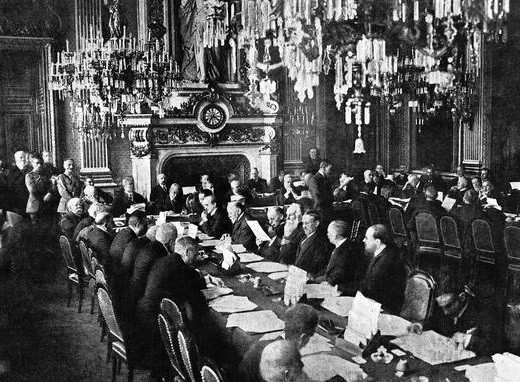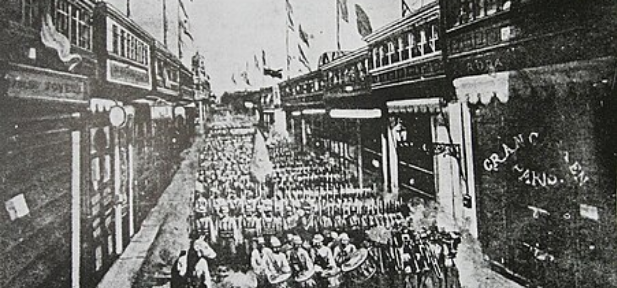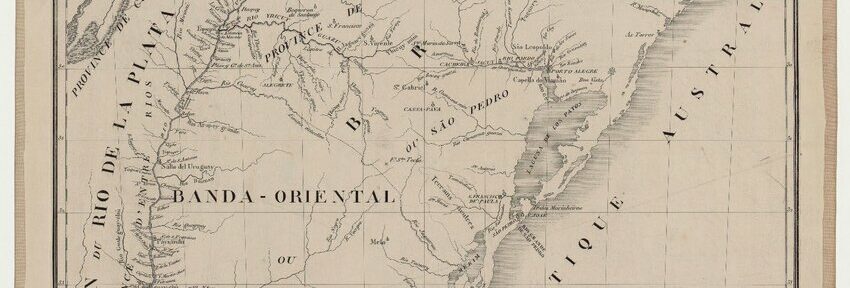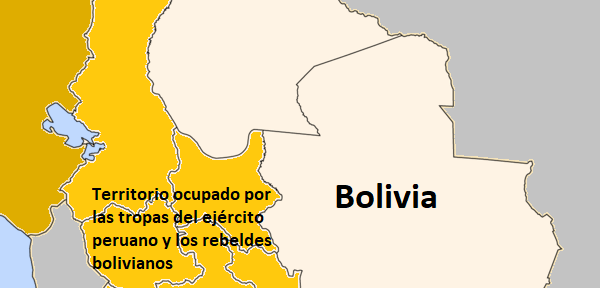TREATY of Peace, Friendship, and Commerce between Bolivia and Chile — Signed at Santiago, October 20, 1904.
Ratifications exchanged at La Paz, March 10, 1906.
In order to carry into effect the purpose indicated in Article VIII of the Truce Convention of the 4th April, 1884, the Republic of Bolivia and the Republic of Chile have agreed to conclude a Treaty of Peace and Friendship, and have for that purpose named and constituted as their Plenipotentiaries, that is to say:
His Excellency the President of the Republic of Bolivia, Don Alberto Gutierrez, Envoy Extraordinary and Minister Plenipotentiary of Bolivia to Chile;
His Excellency the President of Chile, Don Elìlio Bello Codesido, Minister for Forengn Affairs ;
Who, after having exchanged their full powers, and having found them in good and due form, have agreed upon the following :
ART. 1 –
The relations of peace and friendship are restored between the Republic of Bolivia and the Republic of Chile, and in consequence the régime established by the Truce Convention has ceased to exist.
ART. 2 –
By the present Treaty, is recognized the absolute and perpetual sovereignty of Chile over the territories occupied by her in virtue of Article II of the Truce Convention of the 4th April, 1884. page 2
The boundary from south to north between Bolivia and Chile shall be as follows:
From the highest of the Zapaleri Hill (1) in a straight line to the highest crest (2) of the detached ridge towards the south of the Guayaques Hill, approximately in latitude 22° 54′. From here, another straight line will go to the Cajon Pass (3), and then along the watershed of the ridge extending northwards along the crests of the Juriques Hill (4), the volcano of Licancabur (5), the hills of Sairecabur (6) and Curiquinca (7), and the volcano of Putana or Jorjenca (8). From this point, it will continue along one of its spurs towards the Pajonal Hill (9) and in a straight line to the southern crest of the Tocorpuri Hills (10). From there, it will follow the watershed of the Panizo Ridge (11) and the Tatig Range (12). It will then extend northwards along the watershed of the Linzor Ridge (13) and the Silaguala Hills (14). From the northern crest of the Silaguala Hills, it will extend along a spur to the Silala Hillock (16) and then in a straight line to the Inacaliri or del Cajon Hill (17).
From this point, it will proceed in a straight line to the crest that stands in the centre of the group of the Inca or Barrancane Hills (18), and again following the watershed it will proceed north along the ridge of the Ascotan or Del Jardin Hill (19). Frome the crest of this hill it will extend in a straight line to the crest of the volcano of Ollagüe (21).
Frome here in a straight line to the highest crest of the Chipapa Hill (22), descending towards the west along a range of hillocks so as to reach the crest of the Cosca Hill (23).
From this point it will divide the waters of the ridge which following boundary-line:unites it to the Aleoncha Hill (24), and from here to the volcano of Olca (25) along the dividing ridge. Frome this volcano it will continue along the ridge of the bills of Milunu (26). and of Laguna (27), the volcano of Irruputuncu (28), the hills of Bofedal (29) and the Chela (30), and then from a high group of hills it will extend to Milliri (31) and then to Huallcani (32).
Thence it will continue to the Caiti Hill (33), and will follow the watershed to the Napa Hill (34).
From the crest of this hill it will follow in a straight line to a point (35) situated 10 kilom. to the south of the eastern crest of the Huailla Hill (36), whence it will continue in a straight line to the said crest, and from there turninf to the east it will follow along the range of hills of the Laguna (37), Corregidor (38), and Huaillaputuncu (39) to the most easterly stone heap of SSillilica (40), following the ridge which extends in a north-westerly direction to the creast of the Piga Hill (41). From this hill it will follow in astraight line to the highest crest of Tres Cerritos (42), and then in a straight line to the Challacollo Hill (43) and to the narrow part of the Valley of Sacaya (44), opposite Vilacollo. From Sacaya the boundary will go in a straight line to the stone-heaps of Cueva Colorado (45) and to Santaile (46), whence it will follow to the north-west along the hills of Irruputuncu (47) and of Patalani (48). From this creast it will follow in a straight line to the Chiarcollo Hillock (49), crossing the River Cancosa (50), and thence also in a straight line to the PintapintaniHill (51), after which it will continue along the crest of the hills of Quiuri (52), Pumiri (53), and Panantalla (54).
Frome the crest of Panantalla it will continue in a straight line to Tolapacheta (55), half-way between Chapi and Rinconada, and from this point in a straight line to the pass of Huailla (56) ; thence it will extend along the crest of the hills of Lacataya (57) and of Salitral (58). It will deflect towards the north, extending in a straight line to the Tapacollo Hillock (59), the salt bed of Coipasa, and in another straight line to the boundary-mark at Quellaga (60), from which it will continue in a straight lines to the Prieta Hillock (62), to the boundary-marks at Sicaya (63), Chapillicsa (64), Cabarray (65), Trescruces (66), Jamachuma (67), Quimsachata (68), and Chinchillani (69), and crossing the River Todos Santos (70) it will go to the boundary-marks of Payacollo (71) and Carahuano (72) to the Canasa Hill (73) and the Capitan Hill (74). It will then continue towards the north along the watershed of the crest of this point it will go in a straight line to the Puquintica Hill (77).
To the north of the last point Bolivia and Chile agree to fix the following boundary-line :
From the Puquintica Hill (77) the boundary will continue to the north along the ridge that extends to Macaya, crossing the River Lauca at this point (78), then following in a straight line to the Chiliri Hill (79) it will extend to the north along the watershed of the Japu Pass (80) and crests of Quilsachta (81), Tambo Quemado Pass (82), Quisiquisini Hills (83), Huacollo Pass (84), the crests of the Payachata Hills (85 and 86), Larancachua Hill (87), as far as the Casiri Pass (88). From this point it will extend to the Condoriri Hills (89), which divide the waters of the Rivers Sajama and Achuta form those of the Caquena, and it will extend along the ridge which, originating in these hills, goes to the Barbiri Hill (90), passing through the Achuta Pass (91). From the Carbiri Hill it will descend along its slope to the narrows of the River Caquena or Cosapilla (92), above the post-house which also bears the last name. It will then follow the course of the River Caquena or Cosapilla as page 3 far as the confluence (93) of the visible drainage of the open plains pertaining to the Cosapilla Farm, from which confluence it will go in a straight line to the boundary-mark it will follow in a straight line to the Santuario (95), which is to be found to the north of the Maure post-house. It will continue in a north)westerly direction along the ridge which leads to the boundary-mark of the Chipe or Tolacollo Hill (96), the last point of the frountier.
Within six months from the ratification of this Treaty the High Contracting Parties shall appoint a Commission of Engineers to the tender which may be accepted in the respective contract for mark out on the spot the boundary-line, the points of which are enumerated in this Article and indicated in the annexed plan, which shall form an integral part of the present Treaty, and in accordance with the mode of proceeding and at the time which may be agreed upon by special agreement between the two Governments.
Should any dispute arise between the engineers entrusted with the demarcation, which cannot be settled by the direct action of both Governments, the question shall be submitted to the decision of His Majesty the German Emperor according to Article XII of this Treaty.
The private rights legally acquirend by nationals or foreigners in the territories which remain, under this Treaty, under the sovereignty of the one or the other country shall be recognized by the High Contracting Parties.
ART. 3 –
With the object of strengthening the political and commercial relations of both Republics, the High Contracting Parties engage to unite the port of Arica with the Alto de la Paz by a railway the construction of which will be contracted by the Chilean Government at its own cost within the term of one year to be reckoned from the ratification of the present Treaty.
The property of the Bolivian section of this railway shall be vested in Bolivia at the expiration of fifteen years to be reckoned from the day of its completion.
For the same purpose Chile engages to pay the obligations that might be incurred by Bolivia for guaranteeing up to 5 per cent. on the capital invested in the following railways, the construction of which may be undertaken within a term of thirty years: Uyuni to Potosi; Oruro to La Paz; Oruro, viâ Cochabamba, to Santa Cruz; from La Paz to the Beni region; and from Potosi, viâ Sucre and Lagunillas to Santa Cruz.
This obligation cannot bind Chile to an outlay larger than 100,000l. annually, nor exceed the sum of 1,700,000l., which is fixed as the maximum amount that Chile shall assign to the construction of the Bolivian section of the railway from Arica to the Alto de la Paz, and to the guarantees above referred to, and shall be null and void at the end of the said thirty years.
The construction of the Bolivian section of the railway from Arica to the Alto de la Paz, as well as that of the other railways that may be constructed with the guarantee of the Chilean Government, shall be made the subject of special Agreements between the facilities that should be given to the commercial intercourse between the two countries.
The cost of the said section shall be regulated by the amount of the tender which may be accepted in the respective contract for construction.
ART. 4 –
The Chilean Government engages to deliver to the Bolivian Government the sum of 300,000l. in cash in two instalments of 150,000l. each, the first of which shall be paid six months after the exchange of the ratification of the present Treaty, and the second one year after the payment of the first.
ART. 5 –
The Republic of Chile assigns to the final settlement of the claims recognized by Bolivia as indemnities in favour of the Huanchaca, Oruro, and Corocoro Mining Companies, and for paying the balance of the loan raised in Chile in the year 1867, the sum of 4,500,000 gold pesos of 1s. 6d., payable at the option of her Government in cash or in blonds of the external debt valued at the price they may have in London the day on xhich payment shall be made, and the sum of 2,000,000 gold pesos of 1s. 6d., payable in the same manner as the former, for the settlement of the clains arising out of the following obligations of Bolivia: the bonds issued, that is to say, the loan raised, for the construction of the railway between Majillones and Caracoles under the contract of the 10th July, 1872; the debt recognized in favour of Don Pedro Lopez Gana, represented by Messrs. Alsop and Co., who succeeded to the rights of the former; the claims in favour of Mr. John G. Meiggs, represented by Mr. Edward Squire, arising out of the contract entered into on the 20th March, 1876, for the renting of the nitrate fields in Toco; and finally, the amount recognized in favour of Don Juan Garday.
ART. 6 –
The Republic of Chile recognizes in favour of that of Bolivia, and in perpetuity, the fullest and most unrestricted right of commercial transit through her territory and ports on the Pacific.
Both Governments will make, by special Agreements, the necessary regulations to insure, without prejudice to their respective fiscal interests, the purpose above referred to. page 4
ART. 7 –
The Republic of Bolivia shall have the right to establish Custom-house Agencies at such ports that she may select for carrying on her trade. For the present she selects as such ports for her trade, Antofagasta and Arica.
The Agencies shall take care that the goods intended for transit are sent direct from the pier to the railway-station, and that they are conveyed to the Bolivian custom-houses in closed and sealed wagons, and accompanied by way-bills indicating the number of packages, weight and mark, number and contents, which shall be delivered against exchange way-bills.
ART. 8 –
Until the High Contracting Parties shall have concluded a special Commercial Treaty, the commercial intercourse between the two Republics shall be regulated by rules of the strictest equality with those applied to other nations, and under no consideration shall the products of either of the two Parties be placed in conditions of inferiority to those of a third. In consequence, the raw and manufactured products of Bolivia, as well as those of Chile, shall be subject, on being imported and consumed in one or the other country, to the payment of the same dues as those levied on those of other countries, and any favors, exemptions, and privileges that either of the two Parties may grant to a third may, under the same conditions, be claimed by the other.
The High Contracting Parties mutually agree to apply to the national products of one or the other country carried over all the railways crossing their respective territories the same tariff that they may resolve to apply to the most favored nation.
ART. 9 –
The raw and manufactured products of Chile, as well as those mentioned in Article VII, cattle of all kinds and national products of little value may be imported without any formality, and by a simple written declaration in the custom-house.
ART. 10 –
The raw and manufactured products of Bolivia in transit for abroad shall be exported, accompanied by way-bills issued by the custom-houses of Bolivia or by the officials commissioned for the purpose. Agents at the respective ports, and without any further formality these products shall be shipped to the foreign markets. The import trade through the port of Arica shall be carried out with the same formalities as that through Antofagasta, it being necessary at this port to issue way-bills containing the same particulars as those indicated in the preceding
ART. 11 –
As Bolivia is unable to adopt this system immediately, she will continue to observe for the term of one year the one at present in force at Antofagasta, which shall also be applied to the port of Arica, a reasonable term being fixed for putting in force the Tariff of Bolivia, until it is possible to regulate the transit trade in the manner before mentioned.
ART. 12 –
Any difficulties that may arise with regard to the interpretation or execution of the present Treaty shall be submitted to the arbitration of His Majesty the German Emperor.
The ratifications of this Treaty shall be exchanged within the term of six months, and the exchange shall take place in the city of La Paz.
In witness whereof the Envoy Extraordinary and Minister Plenipotentiary of Bolivia and the Minister for Foreign Affairs of ‘Chile signed and sealed in duplicate with their respective seals the ‘present Treaty of Peace and Friendship, in the city of Santiago, on ‘the 20th October, 1904.
(L.S.) A. GUTIERREZ.
(L.S.) EMILIO BELLO C.
At Santiago, on the 20th day of the month of October, 1904, Senor Don Alberto Gutierrez, Envoy Extraordinary and Minister Plenipotentiary of Bolivia, and Senor Don Emilio Bello Codesido, Minister for the Department, duly authorized by their respective Governments, having met in the Department of Foreign Affairs, and taking into consideration that the Governments of Bolivia and Chile, agreeing upon the stipulations laid down in the Treaty of Peace and Friendship concluded and signed on the same date, engaged to substitute the customs privileges solicited by Chile in favor of the Chilean natural products and manufactures thereof for other facilities which do not clash with the object of Bolivia, which is to preserve her absolute commercial liberty, and as there exists an Agreement between the two Governments to lay down in a special instrument the interpretation and scope of the 5th clause of Article III of the said Treaty, in which reference is made to the facilities which, under the Railway Conventions, shall be given to the commercial intercourse between the two countries, agreed upon the following:
The natural and manufactured products of Chile imported into Bolivia shall enjoy on the railways constructed on Bolivian territory At the guarantee of the Chilean Government, a rebate of not less than 10 per cent on the freight charges on the said railways. Bolivia shall take the necessary steps in order that the same or a similar advantage may be accorded to the Chilean products on the Bolivian section of the railway from Antofagasta to Oruro. page 5
In consequence, both in the special Conventions to be concluded between the Governments of Bolivia and Chile for the construction of railways in conformity with the stipulations laid down in Article III of the Treaty of Peace and Friendship, and in the contracts relating to the construction and working of the several lines therein referred to, the obligation of allowing the said rebate to Chilean products shall be laid down.
In witness whereof the Envoy Extraordinary and Minister Plenipotentiary of Bolivia and the Minister for Foreign Affairs of Chile sign the present Protocol in duplicate, and affix thereto their respective seals.
(L.S.) A. GUTIERREZ
(L.S.) EMILIO BELLO C.
AGREEMENT between the Argentine and Paraguayan Governments for the Appointment of a Commission for dermining the Arm or Channel of the River Pilcomayo which constitutes the Boundary.- Signed at Buenos Ayeres, September 11, 1905.
His Excellency Dr. Carlos Rodriguez Larreta, Minister for Foreign Affairs and Worship of the Argentine Republic, and his Excellency Dr. José Z. Caminos, Envoy Extraordinary and Minister Plenipotentiary of Paraguay, having met together in the Ministry For Foreign Affairs and Worship in the city of Buenos Ayres on the 11th day of the month of September, 1905, with the object of deciding which may be the arm or principal channel of the River Pilcomayo, which, according to the Treaty of the 3rd February, 1876, entered into by both countries, and to the Arbitral Award of Mr. Rutherford B. Hayes, President of the United States of America, given on the 12th November, 1878,* is the boundary-line of the two countries in the part situated in the territories of the Chaco, have agreed to the following:—
ART. 1 –
The Government of the Argentine Republic on the one part and the Government of the Republic of Paraguay on the other, agree to appoint a Joint Commission, composed of two experts appointed by the former and two appointed by the latter, charged with the duty of making the necessary studies on the River Pilcomayo, in order to ascertain which is the arm or principal channel of the said river, according to the Treaty and Arbitral Award which have been before referred to.
ART. 2 –
The studies and survey of the river having come to an end, the result of which the Commission shall set forth in a log book, (« diaro de navegacion »), which it shall keep in duplicate, the Commissioners shall present them, together with a report of their labours and a chart of the said river, to their respective Governments.
ART. 3 –
The Argentine and PAraguayan Governments shall, by means of their Representatives, examine the matter in the city of Buenos Ayres, taking into consideration this chart and the documents mentioned in the foregoing Article, in order to define the arm of the River Pilcomayo which must be considered as the principal channel in accordance with the Treaty of 1876 and the Arbitral Award before mentioned.
ART. 4 –
Each of the Contracting Governments shall pay the expenses of their Delegates, and the half of the joint expenses incurred by rhe Commission in the execution of the duties set forth in Article II.
In witness whereof the Plenipotentiaries of either Republic, dely authorized thereto, sign and seal the present Agreement in duplicate in the city and on the date ut supra.
(L.S.) C. RODRIGUEZ LARRETA.
(L.S.) JOSE Z. CAMINOS.
Ministry for Foreign Affairs and Worship,
Buenos Ayres, Spetember 11, 1905.
PROTOCOL between Bolivia and Chile ecplanatory of Article VIII of the Treaty of the 20th October, 1904, as to Exemption of Chilean Gods from Duties.- signed at La Paz, September 10, 1905.
At La Paz, on the 10th September, 1905, there being met in the Ministery for Foreign Affairs, Senor don Beltran Mathieu, Envoy Extraordinary and Minister Plenipotentiary of Chile, and Don Claudio Pinilla, Minister of the Department, having in view the divergent interpretation given to Article VIII of the Treaty of the 20th Octobre, 1904, by the custom-house officials of the two countries, which renders it necessary that an Agreement should be arrived at in order to obviate the inconvenience caused thereby to trade, and being duly authorized by their respective Governements, have agreed as follows:
In accordance with the terms of the Treaty of the 20th October, 1904, until the Government of Bolivia gives effect to its intention…





